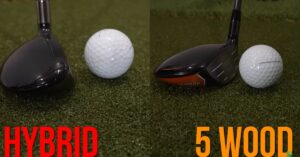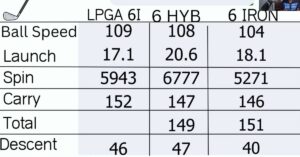Fairway Wood Vs Hybrid: Choosing The Right Club For Your Game
When it comes to choosing the right club for your game, there are a few factors to consider. Two clubs that often come up in the decision-making process are the fairway wood and the hybrid. So, what’s the difference between a fairway wood and a hybrid?
The main difference is the loft. A fairway wood has a loft of 15-18 degrees, while a hybrid has a loft of 17-21 degrees. This means that the fairway wood will launch the ball higher and carry farther, while the hybrid will be easier to hit off the tee and from the rough.
In this blog post, we’ll explore the differences between a fairway wood and hybrid golf club to help you determine which one is best for your game.
Fairway Wood Vs Hybrid: What Are The Differences?

Fairway woods and hybrids are both long-iron alternatives that can be used off the tee or from the fairway. They have some key differences, however, that may make one a better choice for you than the other.
| Aspect | Fairway Wood | Hybrid |
| Loft | 15-18 degrees | 17-21 degrees |
| Launch angle | Higher | Lower |
| Carry distance | Longer | Shorter |
| Forgiveness | Less | More |
| Shot shaping ability | Less | More |
| Feel | Clickier | Softer |
Loft
A fairway wood typically has a loft ranging from 15 to 18 degrees, while a hybrid’s loft falls between 17 and 21 degrees. The loft angle plays a crucial role in determining how high and far the ball will travel after impact.
With a higher loft, the fairway wood will launch the ball higher into the air, resulting in greater carry distance. This can be advantageous when trying to reach distant targets or carry hazards on the course.
On the other hand, the hybrid’s slightly lower loft means it may not launch the ball as high, but it provides an advantage for shots off the tee and from the rough, as the lower trajectory helps the ball cut through challenging lies with more ease.
Launch Angle
Due to the fairway wood’s higher loft, it naturally launches the ball higher into the air compared to a hybrid. While the increased launch angle contributes to greater carry distance, it can also make the fairway wood more challenging to control, especially on off-center hits.
The higher launch makes it susceptible to catching wind, potentially affecting the shot’s accuracy and direction.
In contrast, the hybrid’s lower launch angle provides more shot control and stability, making it easier to maintain accuracy and consistency, even when the ball is not struck perfectly.
Carry Distance
The higher launch angle of the fairway wood allows it to carry the ball farther through the air compared to a hybrid.
This makes it an ideal choice for golfers looking to achieve maximum distance on their shots, particularly when trying to reach long par-5s or carry hazards off the tee.
However, the hybrid compensates for its slightly lower carry distance with additional roll after landing. The ball’s lower trajectory encourages it to roll more on the fairway, which can help close the gap in overall distance between the two clubs.
Forgiveness
The forgiveness of a club refers to its ability to maintain consistent performance even on off-center hits. In this regard, the hybrid has the upper hand over the fairway wood.
The larger head size and higher loft of the hybrid contribute to a more forgiving nature. When a shot is mishit and doesn’t find the center of the clubface, the hybrid is less likely to veer off course compared to a fairway wood.
The smaller head size and lower loft of the fairway wood can lead to less forgiveness, making it crucial for golfers to strike it precisely to achieve the desired results.
Shot Shaping Ability
When it comes to shot shaping, the hybrid offers greater versatility than a fairway wood. The combination of its larger head size and adjustable loft options enables golfers to manipulate the ball flight more effectively.
Skilled players can easily shape shots with a hybrid, hitting draws or fades as needed to navigate around obstacles or position the ball strategically.
Conversely, the fairway wood’s smaller head size and lower loft make it less conducive to manipulating shot shapes, limiting the golfer’s ability to control the ball’s flight path.
Feel
The “feel” of a golf club refers to the sensation a golfer experiences upon impact with the ball. In this aspect, the fairway wood and the hybrid can differ due to their design characteristics.
The fairway wood’s smaller head size and lower loft often give it a “clickier” feel, which some golfers appreciate as it provides immediate feedback on the shot.
On the other hand, the hybrid’s larger head and higher loft may produce a different feel, which some golfers might prefer for its sense of stability and ease of use.
The preference for feel can vary among golfers and can be a personal choice when selecting between the two clubs.
Fairway Wood Vs Hybrid: What Are The Similarities?

Fairway woods and hybrids are both long-iron alternatives that can be used off the tee or from the fairway. They have some key similarities, here they are:
Both Are Long-Iron Alternatives
Fairway woods and hybrids serve as excellent alternatives to the traditional long irons found in a golfer’s bag.
Long irons, such as the 3-iron or 4-iron, can be challenging to hit for many players due to their smaller clubheads and lower levels of forgiveness.
Fairway woods and hybrids, on the other hand, are specifically designed to replace these long irons and offer several advantages.
They are easier to hit, providing more distance and forgiveness, making them a popular choice for golfers seeking improved performance and consistency.
Both Can Be Used Off The Tee Or From The Fairway
One of the key strengths of both fairway woods and hybrids is their versatility in shot selection.
Golfers have the flexibility to use these clubs either off the tee for long and accurate drives or from the fairway to reach distant greens.
The fairway woods are particularly useful for achieving impressive distance off the tee, while hybrids are well-suited for various lies and scenarios on the fairway.
This adaptability allows golfers to confidently approach different situations during a round, adding to their overall confidence and performance.
Both Have A Large Head Size
The head size of both fairway woods and hybrids is larger compared to traditional long irons.
This increased head size results in a larger sweet spot on the clubface, which is the area that delivers optimal performance and minimal distance loss on off-center hits.
As a result, fairway woods and hybrids offer more forgiveness, meaning even if a golfer slightly mis-hits the ball, they are more likely to achieve acceptable results.
The larger head size instills added confidence in golfers, knowing that their shots have a higher chance of being successful and on target.
Both Have A Metal Face
Fairway woods and hybrids come equipped with clubfaces made of metal, which contributes to their ability to generate increased ball speed and distance.
The metal face construction helps to transfer more energy from the clubhead to the golf ball upon impact, resulting in shots that travel farther down the fairway or towards the green.
This additional distance can be highly beneficial, especially when trying to reach longer holes or when facing challenging shots from the rough.
The metal face technology in these clubs aids in maximizing performance and is a significant factor in why golfers prefer using them as alternatives to long irons.
Fairway Wood Vs Hybrid: Which One Is Better?

Fairway woods and hybrids both have their advantages, and the better club for you depends on your playing style and preferences.
If you have a fast swing speed and want maximum distance, a fairway wood might be better. On the other hand, if you have a slower swing speed and want more forgiveness, a hybrid could be the right choice.
The course conditions, your playing style, and your individual needs are crucial factors to consider. The best approach is to try both clubs and seek advice from a golf instructor.
Remember, there is no definitive answer; it’s about finding what works best for you.
Frequently Asked Questions
Both clubs are designed to help with long shots, but they have distinct features that cater to different playing styles and skill levels. Let’s explore the key differences in this quick and clear FAQ section:
Which Is Easier To Hit?
Hybrids are generally easier to hit due to their design and higher forgiveness, making them suitable for beginners and players with slower swing speeds.
Can Fairway Woods Be Used From The Rough?
Yes, fairway woods can be used from the rough, but their larger heads may result in more difficulty compared to hybrids.
Are Hybrids Suitable For Tee Shots?
Yes, hybrids are versatile clubs and can be used for tee shots, especially on shorter par-3 holes or when accuracy is crucial.
What About Trajectory Differences?
Fairway woods tend to have a lower trajectory, which is preferred by some players, while hybrids offer a higher trajectory for softer landings.
Which Club Should I Choose?
Choose a fairway wood if you have a consistent swing and desire maximum distance, and opt for a hybrid if you need more forgiveness and versatility on the course. Personal preference and trying both clubs are the best ways to decide what suits your game best.






